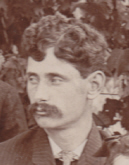Welcome to the Duval family history page! This site is devoted to Charles and Sarah
(St. Aubin) Duval, who came to Wisconsin from Canada in 1873, and to their eight
children, thirty-
- Our first Duval ancestor to come to Canada, Charles’s great-
great- great grandfather, was a baker who arrived in Montréal shortly after 1700. He came from the town of Tonnerre, in Burgundy, about 120 miles southeast of Paris. The family name did not finally become Duval until emigration to the United States in 1873. Before then, it was Thuot (pronounced TYOO- et). - Our first St. Aubin ancestor to come to Canada, Sarah’s great-
great- great- great grandfather, arrived in Montréal as a teenager in about 1665 and was initially employed as a servant by the king’s attorney there. He came from Dieppe, in Normandy, on the north coast of France. - For the next two centuries, the Duval and St. Aubin families lived in Montréal and in the small farming communities to the south of the city.
- There are 745 documented ancestors in our family tree, and all but four were French.
The exceptions were one Spaniard, one Swiss, one Dutchman, and one African. There
were no Native American (Indian) ancestors at all. In the entire family tree, extending
more than 400 years, there were only two out-
of- wedlock births. - Of our 745 ancestors, 185 were immigrants to Canada. They were especially prominent among the founding families of Montréal, and they were nearly all peasants and laborers, although some acquired artisanal skills. There were no noble lineages, merchants, or significant government officials among them.
- Our most famous ancestors were Louis Hébert and his wife Marie Rollet, considered to be the first French family to settle in Canada, in 1617.
- We’re related to Angelina Jolie, Madonna, Celine Dion, Alec Baldwin, Jim Carrey,
Hillary Clinton, and to virtually everyone else who has French-
Canadian ancestors in his family tree. We’re also related to Saint André of Canada, canonized by the pope in 2010.
If you’d like to know more, read on . . .
OUR HISTORY IN CANADA
FRANCE AND THE FOUNDING OF CANADA
European settlement of North America began in earnest four centuries ago. The Puritans established themselves in New England, the Dutch founded New Netherland on the Hudson River, English cavaliers laid out tobacco plantations in Virginia, the Quakers began the colony that would become Pennsylvania, and the French sent settlers to Québec and Montréal on the St. Lawrence River.
American schoolchildren are familiar with the narratives of the early settlements that became the United States. Many of the colonists sought to practice their religious beliefs without interference, especially the Puritans and the Quakers. Many of them sought economic opportunity as they fled their crowded homelands and claimed the abundant farmland of the New World. They developed agriculture and industry that both served their own needs and yielded exports to Europe and the Caribbean. And they steadily pushed the Indian peoples westward, often in bloody conflict, as they expanded the frontier.
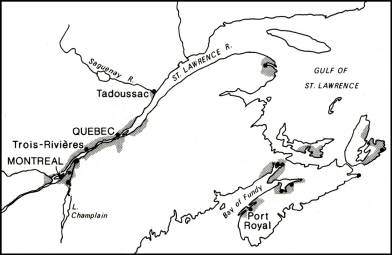 The narrative of the French in Canada is quite different. No one came in search of
religious freedom, because only Catholics were allowed to settle. Few came for economic
opportunity, because the French government strictly controlled land holding and insisted
that the colonists trade only with France and not engage in manufacturing. From the
start agriculture was difficult because of the short growing season and harsh winters.
The trade in fur, of beavers and other forest animals, was lucrative but was limited
to a small class of merchants. And while periods of conflict with the Indians occurred,
cooperation with them was the norm, given the small numbers of French settlers in
Canada and the importance of the Indians in the fur trade.
The narrative of the French in Canada is quite different. No one came in search of
religious freedom, because only Catholics were allowed to settle. Few came for economic
opportunity, because the French government strictly controlled land holding and insisted
that the colonists trade only with France and not engage in manufacturing. From the
start agriculture was difficult because of the short growing season and harsh winters.
The trade in fur, of beavers and other forest animals, was lucrative but was limited
to a small class of merchants. And while periods of conflict with the Indians occurred,
cooperation with them was the norm, given the small numbers of French settlers in
Canada and the importance of the Indians in the fur trade.
The French were drawn to the New World by codfish and beaver pelts, but if this had
been the whole story, they would never have founded settlements in Canada, because
neither commodity required a permanent presence on land. The fishing boats came seasonally
and then returned to France with their catches, and the fur traders preferred to
visit the coastline briefly to trade European goods for animal skins trapped by the
Indians. But the kings of France had larger objectives: they planned to confront
and restrict the British as they attempted to dominate North America, and they also
hoped that the St. Lawrence River would ultimately lead to the fabled Northwest Passage
-
THE SETTLEMENT OF NEW FRANCE
To achieve their objectives, the French monarchs engaged a series of investors and
adventurers, some organized in joint-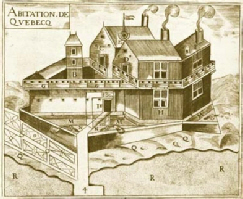 established a settlement in 1605 and spent the winter
there; in 1606 he was joined by our most notable ancestor, Louis Hébert. In 1608,
Champlain founded the first settlement on the St. Lawrence, at the site of Québec
City. In 1617, he established the first French settler family there: our ancestor,
Louis Hébert, this time accompanied by his wife, Marie Rollet, and their three children.
established a settlement in 1605 and spent the winter
there; in 1606 he was joined by our most notable ancestor, Louis Hébert. In 1608,
Champlain founded the first settlement on the St. Lawrence, at the site of Québec
City. In 1617, he established the first French settler family there: our ancestor,
Louis Hébert, this time accompanied by his wife, Marie Rollet, and their three children.
The settler population grew very slowly, however. The king required that merchants
bring settlers to Canada on each voyage, and he granted large estates there to noblemen
on the condition that they send peasants to cultivate the land. But it was not easy
to attract settlers to the distant colony, and the merchants and noblemen largely
evaded their commitments. So unattractive was the prospect of emigration that laborers
were given contracts that guaranteed them not only a competitive wage for a specified
period of time but also return passage to France. During the 1600s, nearly three-
By the late 1630s, there were barely 500 Frenchmen living in all of New France, mostly
single men, although a few married couples had been convinced to settle. Among them
were a dozen of our ancestors, farming land in and around Québec City. Then, in 1640,
a group of pious French noblemen and noblewomen received permission to found a new
settlement farther up the St. Lawrence River, on an island that was the site of periodic
markets where Indians traded furs for French manufactured goods. Their intentions
were entirely spiritual, in line with the intense Catholic Counter-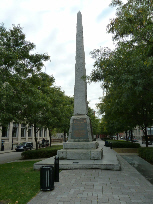 Among the fifty men and women who arrived to establish the new
settlement in 1642 was our ancestor Augustin Hébert, whose name can be seen on the
monument to their achievement that stands today near the site of their first settlement.
They named the place Ville-
Among the fifty men and women who arrived to establish the new
settlement in 1642 was our ancestor Augustin Hébert, whose name can be seen on the
monument to their achievement that stands today near the site of their first settlement.
They named the place Ville-
Despite the ambitious plans of the founders of Montréal and the fact that, astonishingly, all of the settlers survived their first winter there, the new settlement initially failed to prosper. The Iroquois, who were then engaged in a series of wars with neighboring tribes to control trade on the St. Lawrence, killed many of the French settlers, and the founders were no more successful than previous recruiters in convincing young Frenchmen to come to this new and dangerous land. By 1652 the French population of Montréal was still just fifty, and the founders were on the verge of abandoning the project completely, but they decided to make one more effort to entice young men to join the settlement. The result was the celebrated “Great Recruitment,” which brought more than 100 men, as well as several women, to Montréal in 1653 and saved the project from extinction.
This early period in the history of Montréal is particularly important for our family
tree, since the largest single concentration of our immigrant ancestors were participants.
When the ship bearing the Great Recruitment arrived in 1653, eight of our ancestors
were among the fifty surviving settlers in Montréal who greeted it. Of the 57 members
of the Great Recruitment who ultimately established households and families in Montréal,
fifteen were our ancestors. By 1663, the population of the settlement had grown to
596; of this number, 49 were our ancestors. (Even today, after Montréal has become
a major world center, Duval descendants who visit will pass many cousins on the street,
especially in French-
While the survival of Montréal was encouraging, the king of France was profoundly disappointed with the rate of growth of his North American colony. The total population of French settlers on the St. Lawrence in 1663 was just 3,035, while the population of the British colonies to the south had already reached nearly 100,000. In that year he took the important step of assuming direct royal control of the entire colony, limiting the role of merchants to their trading activities.
Under the direction of the king, the following ten years saw a significant increase
in the population of New France. While individuals and couples were still occasionally
recruited by the noble landlords, the king took the lead by dispatching a regiment
of 1,200 young soldiers -
Then, in 1673, the king’s attention was once again drawn to Europe and to his conflicts
with the other major powers. Canada and its settlements declined in importance and
no longer received his direct support in colonization. Although small numbers of
immigrants continued to arrive, and another period of settlement occurred in the
mid-
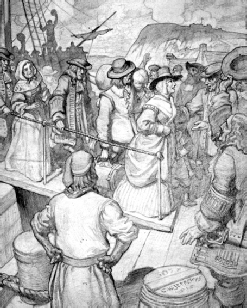 During the entire period of colonization, from 1617 to 1760, around 22,000 French
men and women voyaged to the St. Lawrence Valley. The vast majority of these -
During the entire period of colonization, from 1617 to 1760, around 22,000 French
men and women voyaged to the St. Lawrence Valley. The vast majority of these -
The number of women who came to New France was much smaller, well under 2,000, and
almost none was indentured. Instead, they were recruited and financed by several
public and private programs intended to provide potential wives to the male settlers.
Since they had not been guaranteed return passage to France, and since they had nothing
to return to there in any case, nearly all of them -
From these humble beginnings -
WHO WERE OUR IMMIGRANT ANCESTORS ?
In general the 185 immigrants to New France who are the foundation of the Duval family
tree were representative of the early settler population as a whole. Three-
Their regional origins in France were typical of the general population of New France, in that almost all came from the west and northwest of France, areas that had long been involved with Atlantic commerce. Over half came from just three regions: Normandy, the areas around the western port of La Rochelle, and Paris. Most of the rest originated in nearby Brittany, Poitou, and Maine.
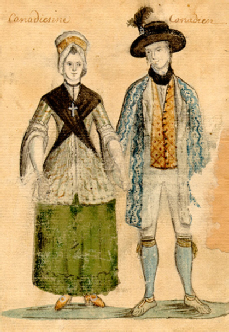 Most of the male immigrants had been trained in a craft, such as carpentry, masonry,
or shoemaking. In fact, it was the mobility and relative freedom that they had attained
in France as part of their training in a non-
Most of the male immigrants had been trained in a craft, such as carpentry, masonry,
or shoemaking. In fact, it was the mobility and relative freedom that they had attained
in France as part of their training in a non-
Although our immigrant ancestors were fairly typical of the Québec population, they
were exceptional in several ways. The most important of these was their relative
concentration in the Montréal area, which resulted from their significant involvement
in the early recruitment efforts there. By 1730, virtually all of our ancestral lines
were living in and around Montréal, either having settled there originally or having
migrated there from Québec City or other settlements on the St. Lawrence. Also important
was the absence of any immigrants later than 1710, even though at least one-
In general, our French Canadian ancestors did not come to the New World because of
poverty or religious persecution in Europe. Many were recruited by local noblemen,
the clergy, the army, or agents of the king. Some came in genuine support of the
religious mission of the Jesuits and other Catholic orders. Many came because it
offered a good job: of limited duration, well-
THE LIVES OF OUR ANCESTORS IN CANADA
The society established by France in Québec in the 17th century was essentially feudal
-
In French Canada, the king was embodied by the governor, established in comfortable
surroundings in Québec City, and by the intendent, who was the king’s administrative
representative. From the beginning of settlement, large tracts of land were granted
as fiefs (in exchange for fealty and hommage, as in the Middle Ages) to noblemen
and religious orders, called seigneurs, who were then expected to recruit peasants
and laborers to emigrate from France and settle on the land in order to make the
colony self-
The landscape was dominated by the St. Lawrence and by the rivers that flowed into
it. Unlike the familiar checkerboard pattern of farms or scattered villages in the
British colonies to the south, 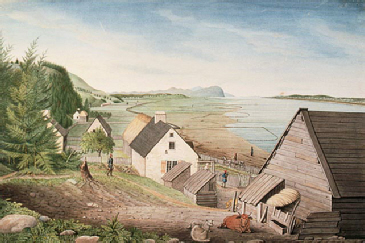 virtually all farms in New France were long and narrow,
with the narrow end fronting on a river and with the family home and barn just a
few steps from the shore, occasionally interspersed with the parish church or the
larger home of the seigneur. In effect, the entire population was arrayed along the
rivers. While not efficient for purposes of defense, this arrangement permitted relatively
easy transportation throughout the year, by canoe or boat during the summer and by
sleigh during the long winter -
virtually all farms in New France were long and narrow,
with the narrow end fronting on a river and with the family home and barn just a
few steps from the shore, occasionally interspersed with the parish church or the
larger home of the seigneur. In effect, the entire population was arrayed along the
rivers. While not efficient for purposes of defense, this arrangement permitted relatively
easy transportation throughout the year, by canoe or boat during the summer and by
sleigh during the long winter -
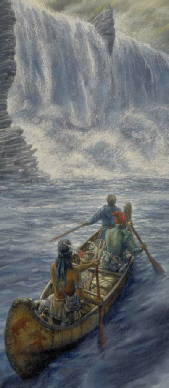 Apart from farming, by far the most important economic activity was fur trading,
mainly of beaver pelts, which were in great demand in Europe for the manufacture
of felt for hatmaking. The proceeds of the fur trade supported a small but prosperous
group of French Canadian merchants and provided enough in taxes and duties to finance
the colonial government in most periods. But most important for our ancestors, it
provided employment for large numbers of young men, who contracted with the merchants
of Montréal to travel by canoe to the Great Lakes and beyond to trade imported manufactured
goods to the Indians for beaver pelts. These year-
Apart from farming, by far the most important economic activity was fur trading,
mainly of beaver pelts, which were in great demand in Europe for the manufacture
of felt for hatmaking. The proceeds of the fur trade supported a small but prosperous
group of French Canadian merchants and provided enough in taxes and duties to finance
the colonial government in most periods. But most important for our ancestors, it
provided employment for large numbers of young men, who contracted with the merchants
of Montréal to travel by canoe to the Great Lakes and beyond to trade imported manufactured
goods to the Indians for beaver pelts. These year-
In addition to the fur trade, there were other elements that made life for common
people in early New France different from, and in many cases better than, life in
Europe. Farmland was much more abundant and could be obtained at a reasonable price,
and the French system of land tenure limited speculation. While fees, rents, tithes,
and labor were due to the seigneur and to the pastor, these were generally not onerous,
and there was no annual head tax -
Yet there were also hardships that gave pause to those who might have emigrated and thus limited the population of the colony. The ocean voyage was difficult and dangerous, even during peacetime, with significant numbers of passengers succumbing to disease en route. The Canadian winters were famously harsh and endless. For long periods during the early years, especially 1643 to 1667 and 1687 to 1701, colonists were vulnerable to attack by Iroquois warriors, who were notoriously cruel to their victims, as described in detail by the written narratives of Jesuit missionaries. (Five of our ancestors were killed by Iroquois raids during this period.) For these and other reasons, the population of New France always remained small: usually around five percent of that of the British colonies of North America.
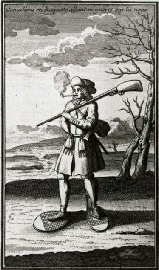 For the men of New France, armed conflict was very much a part of their lives. Throughout
much of the 17th century, they cultivated their fields in groups armed with muskets,
with several men standing guard as the others worked the crops. They had learned
that Iroquois raiders often lay in concealment for days on end, awaiting the opportunity
to seize an unwary colonist. Even during times of peace with the Indians, all men
were required to have firearms and to drill regularly as members of the permanent
militia. The relative lack of regular army troops in New France meant that it was
the peasants who were called out to participate in raids on the British and Dutch
settlements to the south and to defend against counterattacks. As militia members,
they fought beside the Indian allies of the French and learned their tactics of stealth
and ambush. In 1764, General James Murray, the first British governor of Québec,
reported that, “The Canadians are to a man soldiers.” While we lack details of specific
enlistments, we can be certain that many of our ancestors participated as combatants
in all of the major conflicts, including the French and Indian War (1754-
For the men of New France, armed conflict was very much a part of their lives. Throughout
much of the 17th century, they cultivated their fields in groups armed with muskets,
with several men standing guard as the others worked the crops. They had learned
that Iroquois raiders often lay in concealment for days on end, awaiting the opportunity
to seize an unwary colonist. Even during times of peace with the Indians, all men
were required to have firearms and to drill regularly as members of the permanent
militia. The relative lack of regular army troops in New France meant that it was
the peasants who were called out to participate in raids on the British and Dutch
settlements to the south and to defend against counterattacks. As militia members,
they fought beside the Indian allies of the French and learned their tactics of stealth
and ambush. In 1764, General James Murray, the first British governor of Québec,
reported that, “The Canadians are to a man soldiers.” While we lack details of specific
enlistments, we can be certain that many of our ancestors participated as combatants
in all of the major conflicts, including the French and Indian War (1754-
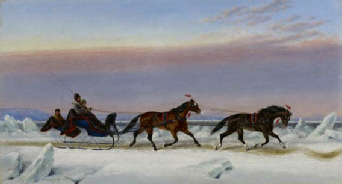 On balance, however, for those who came and settled in New France, life was relatively
prosperous and comfortable compared to that of their countrymen in Europe. Their
nutritional intake was higher, and they tended to be healthier and longer-
On balance, however, for those who came and settled in New France, life was relatively
prosperous and comfortable compared to that of their countrymen in Europe. Their
nutritional intake was higher, and they tended to be healthier and longer-
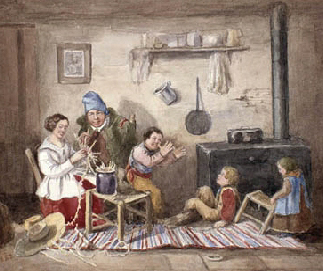 With few exceptions our ancestors were peasants who farmed lands that had been granted
to them on the estates of noble and church landlords. They were subsistence farmers
who produced for their own consumption and for sale to nearby towns, but they did
not seek to expand their farms or to produce a significant surplus, because French
mercantilist policy closed most external markets to them. With a relatively secure
home base, they married young and had many children, often more than ten or twelve
in each generation. The children received little education -
With few exceptions our ancestors were peasants who farmed lands that had been granted
to them on the estates of noble and church landlords. They were subsistence farmers
who produced for their own consumption and for sale to nearby towns, but they did
not seek to expand their farms or to produce a significant surplus, because French
mercantilist policy closed most external markets to them. With a relatively secure
home base, they married young and had many children, often more than ten or twelve
in each generation. The children received little education -
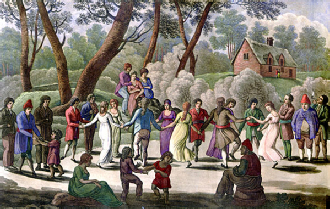 In fact, the benefits of life for the peasantry of New France over time tended to
make them remarkably conservative and resistant to change. Life was good and could
be maintained with a reasonable amount of work, and the typical peasant could provide
for his large family and see his children successfully married and settled on their
own farms. While agrarian reformers favored the abolition of feudalism, which had
in fact consigned much of European peasantry to poverty, French Canadian farmers
saw it as the reliable basis for their security. Crime and social disorder were relatively
rare and, in fact, substantially less common than in Puritan New England.
In fact, the benefits of life for the peasantry of New France over time tended to
make them remarkably conservative and resistant to change. Life was good and could
be maintained with a reasonable amount of work, and the typical peasant could provide
for his large family and see his children successfully married and settled on their
own farms. While agrarian reformers favored the abolition of feudalism, which had
in fact consigned much of European peasantry to poverty, French Canadian farmers
saw it as the reliable basis for their security. Crime and social disorder were relatively
rare and, in fact, substantially less common than in Puritan New England.
The British conquest of New France, in 1759-
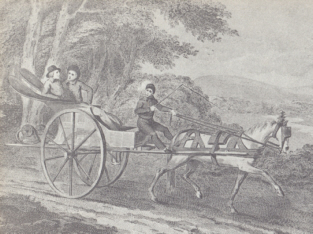 The first fifty years of British rule brought unexpected economic benefits to the
French-
The first fifty years of British rule brought unexpected economic benefits to the
French-
It was not until the 1820s that population growth, due both to natural increase and
to immigration from Britain and Ireland, began to put pressure on land and resources.
It grew increasingly difficult for young men to find suitably sized plots of land
that they could afford, and a population of landless laborers began to rise, with
very little outlet or opportunity in Québec. During this period, our ancestors, who
had been born into families of farm owners, grew up instead to lives of day-
STORIES OF OUR ANCESTORS
LOUIS HÉBERT AND MARIE ROLLET
Louis Hébert, who is well-
Louis’ interest and involvement in the New World was inspired by Jean de Biencourt
de Poutrincourt, who had married Louis’ first cousin in 1590. Poutrincourt was the
scion of a distinguished and wealthy noble family of northern France who had decided
to expand his domain by establishing himself in the Americas. He toured the coasts
of Acadia (modern Nova Scotia and New Brunswick) during the summer of 1604, and in
February of 1606 he requested and was granted a fiefdom in Acadia by King Henri IV
on the condition that he establish a colony there. Poutrincourt proceeded immediately
to his task and in May of that year departed France on a well-
Poutrincourt’s companions, all young men, were no ordinary group of people. His vision
of his Acadian fiefdom was inspired by the world that he had known in France: a tightly-
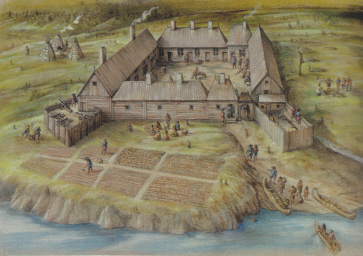 Thus our ancestor set foot in the New World on July 27, 1606, when Poutrincourt’s
ship arrived at Port-
Thus our ancestor set foot in the New World on July 27, 1606, when Poutrincourt’s
ship arrived at Port-
During the fall of 1606, Poutrincourt and Champlain, accompanied by Louis Hébert and a small crew of sailors, explored the western shore of the Bay of Fundy (the coast of modern New England and New Brunswick) in search of appropriate sites for expansion of the colony. While they sought friendly relations with the local bands of Indians, they found that earlier European contacts had rendered them suspicious and sometimes hostile, especially as they sailed down the coast into the area that would later become Massachusetts. In early October they had a particularly close call, when they landed on the coast of Cape Cod, near modern Chatham, and set up a temporary encampment. During the night, five crew members, who had insisted on staying on shore despite orders to return to the boat, were attacked by a large group of Indians. Champlain and Louis Hébert, with others of the company, immediately rowed ashore and drove off the attackers, but four of the insubordinate sailors were killed.
The explorers then returned to Port-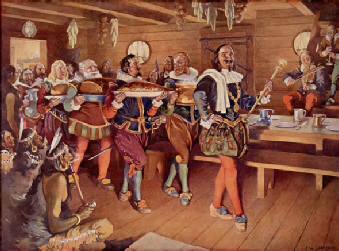 performed by the colonists, afloat in canoes and in full costume,
as the voyagers approached Port-
performed by the colonists, afloat in canoes and in full costume,
as the voyagers approached Port-
The winter of 1606-
Despite the evident success of this year of settlement in Port-
Arriving in Nova Scotia in the spring of 1610, the men began to rebuild the settlement
in Port-
While we have no evidence regarding Louis’ family during his extended absences in
the New World, it seems very likely that they became part of a network of the wives
and families of the men who had accompanied Poutrincourt to Acadia, including Poutrincourt’s
wife, Claude Pajot, who was Louis Hebert’s first cousin. Historians are not in agreement
as to whether Louis was in unbroken residence in Acadia between 1610 and 1614, but
he was there during most of the period, returning to France briefly if at all. Thus,
he had been away from France for five of the first twelve years of his marriage (1606-
Back in Paris in 1614 and once again established as an apothecary, Louis evidently grew restless. Although he continued to serve as solicitor for Poutrincourt’s son, he regretted being out of personal touch with the New World. When Samuel de Champlain, in Paris in 1617 to conduct business for the settlement that he had established at the future site of Québec City, proposed to him that he and his family move there, Louis evidently leapt at the opportunity. (We do not know his wife’s reaction.) Champlain approached the company of French merchants who then held a trading monopoly on the St. Lawrence, negotiating an agreement with them that the Hébert family would settle in Québec, with Louis to serve as their salaried employee and apothecary, with a small plot of land for farming. Louis soon arranged for the sale of his Paris property and proceeded with his family to the port of Honfleur in preparation for the voyage. While there, he learned to his astonishment that the merchant company had reneged on many of its commitments to him and reduced his promised salary by half. The merchants were, in fact, opposed to permanent colonists, who might seek to undercut their control of the fur trade and who might disrupt their crucial bartering relations with the Indians. However, since Louis had irrevocably sold his assets in France, he decided to proceed with the venture.
Louis, Marie, their three children, and their manservant arrived in Québec in July
1617. The settlement had been in existence for nine years and still consisted of
a just few dozen men, most of them transient and involved in the fur trade, with
no women or children at all. 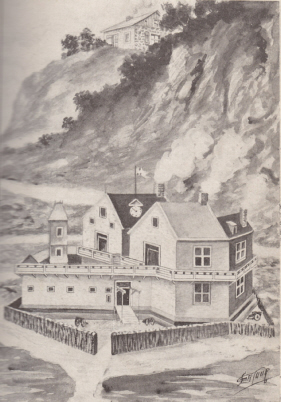 The Héberts erected a temporary dwelling near the official
residence (habitation) that Champlain had built in the lower part of the town near
the river, and within a few months they completed a stone house on the high bluff
above the habitation, not far from the location of the majestic Château Frontenac
today. They planted crops and a garden nearby, and Champlain was able to report the
following year that, “I visited the cultivated land, which I found planted and filled
with fine grain, the gardens full of all kinds of vegetables, such as cabbage, turnips,
lettuce, rhubarb, sorrel, parsley, and other plants, as well developed as in France.
In short, everything was manifestly prospering.”
The Héberts erected a temporary dwelling near the official
residence (habitation) that Champlain had built in the lower part of the town near
the river, and within a few months they completed a stone house on the high bluff
above the habitation, not far from the location of the majestic Château Frontenac
today. They planted crops and a garden nearby, and Champlain was able to report the
following year that, “I visited the cultivated land, which I found planted and filled
with fine grain, the gardens full of all kinds of vegetables, such as cabbage, turnips,
lettuce, rhubarb, sorrel, parsley, and other plants, as well developed as in France.
In short, everything was manifestly prospering.”
This was a substantial achievement, given that the merchant company had refused to allow the Héberts to have a plow. This impediment, plus the demands on Louis’ time for company business and for providing medical care to the settlement and the local Indians, limited the development of his farm. Although he was granted a small fief in 1623 (today the site of the basilica and the seminary in Québec City), which was ennobled and expanded in 1626, by the 1630s the Hébert family still had only six acres under crops. More important, however, Louis and Marie provided a vital center for the community. Their home was for years the finest private structure in the town, and residents gathered there regularly. In 1621 Louis was appointed king’s attorney, which made him responsible for conveying all laws, regulations, and public documents. He was always generous with his time, and Marie gave instruction in their home to the local children, both French and Indian. Still, it was a challenging and lonely existence; during the ten years following their arrival, just three more French families joined them in Québec.
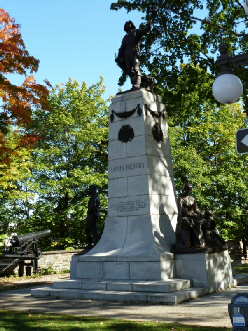 In the winter of 1626, Louis was badly injured in a fall on the ice and never recovered.
He died on January 25, 1627. He left behind his widow, who remarried sixteen months
later, and his two surviving children: daughter Guillemette, who had married Guillaume
Couillard in 1621 and was to have ten children; and son Guillaume, who married Hélène
Desportes in 1634 and had three children before his untimely death in 1639 at the
age of 31. It is from the latter Guillaume’s daughter Françoise, born in 1638, that
we descend.
In the winter of 1626, Louis was badly injured in a fall on the ice and never recovered.
He died on January 25, 1627. He left behind his widow, who remarried sixteen months
later, and his two surviving children: daughter Guillemette, who had married Guillaume
Couillard in 1621 and was to have ten children; and son Guillaume, who married Hélène
Desportes in 1634 and had three children before his untimely death in 1639 at the
age of 31. It is from the latter Guillaume’s daughter Françoise, born in 1638, that
we descend.
In 1678, Louis’ remains were transferred with honor to the newly erected Recollet
chapel and were among the first to rest there. Today there is an impressive monument
to him and his family in Montmorency Park, beside the basilica in Québec City and
near the location of his first farm. There is also a plaque on the façade of his
birthplace in Paris, the shop/residence called the Mortier d’Or (Golden Mortar),
at 129 rue Saint-
NICOLAS MARSOLET
Our most colorful and controversial ancestor by far was Nicolas Marsolet: early companion of Champlain, one of the first Frenchmen to live year round in the St. Lawrence Valley, master of Indian languages, fur trader, merchant, and, ultimately, prosperous landowner and distinguished resident. His life illustrates some of the most dramatic episodes in the early history of Québec.
Samuel de Champlain, who is generally considered to be the founder of New France,
adopted a strategy of allying and cooperating with the Indian peoples of Canada rather
than attacking and subduing them. This was entirely a matter of necessity, since
it was clear to him that the French kings, who were deeply absorbed in the politics
of Europe, would never devote sufficient resources to the New World to support a
large French population and a conquering army. From the outset, therefore, Champlain
sent young men to live among the various Indian groups as truchements, which means
translator but much more as well: in the words of historian D.H. Fischer, these men
“were instructed to explore the country, live among the Indian nations, master native
languages, promote trade, build alliances, observe carefully, and report on what
they saw.” They were not typical agents of the French, however. In fact, they were
often traded to the Indians in a form of hostage exchange meant to ensure peace.
They were to live with the Indians, share their way of life, and support themselves
in the same way as their hosts. When Champlain and other French representatives wished
to communicate and negotiate with the Indians, they expected to be able to call on
these young men to step forward as well-
Nicolas Marsolet was born in Rouen, Normandy, in 1601 and was just twelve years old
when he was selected to be a truchement. In the spring of 1613 he departed France
aboard Champlain’s sixth voyage to North America.  Upon arrival, he was placed with
the Montagnais Indians of the Saguenay Valley, above Tadoussac, a trading settlement
on the St. Lawrence River. Here he was integrated into a selected family and shared
their lives in every aspect, and he evidently enjoyed it, finding their freedom,
expressiveness, adventure, and casual regard for authority to be preferable to his
experiences among his own countrymen. He learned to speak the Indians’ language,
to respect their customs, and to travel by canoe as they did, and he also learned
to support himself in their way, by hunting and fishing and by trading with distant
Indians for beaver pelts to exchange for manufactured goods imported by European
merchants on the St. Lawrence River.
Upon arrival, he was placed with
the Montagnais Indians of the Saguenay Valley, above Tadoussac, a trading settlement
on the St. Lawrence River. Here he was integrated into a selected family and shared
their lives in every aspect, and he evidently enjoyed it, finding their freedom,
expressiveness, adventure, and casual regard for authority to be preferable to his
experiences among his own countrymen. He learned to speak the Indians’ language,
to respect their customs, and to travel by canoe as they did, and he also learned
to support himself in their way, by hunting and fishing and by trading with distant
Indians for beaver pelts to exchange for manufactured goods imported by European
merchants on the St. Lawrence River.
For most of the preceding century, his Montagnais hosts had been at the center of
the fur trade. Their settlement at Tadoussac, relatively near the entrance of the
St. Lawrence, was a convenient port for French and other merchants, and the Montagnais
used this focal point to become prosperous middle-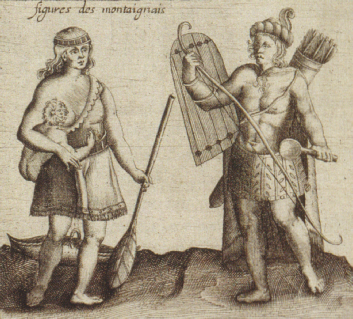 The Montagnais vigorously
protected their position by preventing the French from going up the Saguenay River
to make direct contact with their Indian trading partners.
The Montagnais vigorously
protected their position by preventing the French from going up the Saguenay River
to make direct contact with their Indian trading partners.
There was an inherent conflict between the interests of the Montagnais and the French
after 1600, the year in which the French first attempted to establish a permanent
trading post at Tadoussac. The French planned to settle colonies in the St. Lawrence
Valley, but they intended them to be self-
Marsolet, like many of his fellow truchements, eventually fell afoul of French Catholic missionaries, especially as the latter became more numerous in the area in the 1620s. The missionaries felt that the young Frenchmen, who tended to live morally casual lives and ignore the disapproval of the priests, were a negative influence on the Indians, creating an inappropriate image of French civilization and undercutting the missionizing efforts of the Church. In about 1626, the Jesuit fathers demanded that some of the truchements be expelled and returned to France, and Marsolet was evidently among them, providing another source of resentment toward the French authorities.
By 1629 Marsolet had found his way back to Tadoussac, where he was on the scene when
a fleet of British privateers commissioned by Charles I of England took possession
of the French St. Lawrence settlements under the misapprehension that Britain and
France were at war. Since the British offered a freer environment for trade and were
also willing to sell them liquor in exchange for beaver pelts -
Not surprisingly, Champlain accused Marsolet of treason, but he could take no action against him because he had surrendered New France and was now in British custody. To compound the offense, Marsolet testified against Champlain’s plan to take two young Montagnais Indian girls to France with him and was able to convince the British to deny Champlain his wishes, angering him even more.
The incident of Champlain and the Montagnais girls is worth examining in detail, since it has received considerable attention from historians and has tended to color their judgment of both Champlain and Marsolet. In Champlain’s telling, in 1627 he had adopted the two Indian girls, aged 11 and 12, at the request of their parents. He had taken them into his home, renamed them Hope and Charity, and cared for them under the watchful eye of local Catholic priests. When the British declared their intention to deport him to France in 1629, he requested that the girls accompany him, which, according to Champlain, they ardently desired to do. Marsolet spoke out against the plan, suggesting that Champlain’s intentions were less than honorable and that the girls’ parents were opposed to their going. In reply, Champlain lashed back at Marsolet, accusing him of lying and of wishing to have the girls for himself. The British listened to the dispute and ruled against Champlain; the girls stayed in Canada.
Since historians have tended to describe Champlain as nearly a saint, they have typically
judged that he was unfairly treated in this incident and that Marsolet was a scoundrel
or worse. But it is necessary to dissect Champlain’s self-
It should also be noted that sixteen years earlier Marsolet, then just twelve years
old, had spent two months aboard ship as Champlain’s cabin boy and may consequently
have learned some things about his attitudes and behavior toward children -
Finally, the judgment of the British privateers who ruled against Champlain should be dispositive. They were educated and sophisticated men of Champlain’s class who shared many of his experiences at sea and at war, and they displayed their personal affinity for him by treating him as their equal during his captivity, even to the extent of taking him on hunts with them. Yet they gave credence in this incident to Marsolet, who to them was little more than a servant. Perhaps most telling is the fact that Champlain himself never formally charged Marsolet with treason or any other crime, despite the fact that throughout this period, apart from his brief captivity by the British, he remained lieutenant general of New France and was fully empowered to take legal action. It is quite possible that Champlain avoided a formal, public airing of his charges against Marsolet lest it uncover inconvenient details that were inconsistent with his carefully cultivated image. While we will never know the exact circumstances of the affair of Champlain and the two Indian girls, we should certainly consider the likelihood that Marsolet acted honestly and honorably and that the final judgment of the British was justified.
Marsolet remained in New France during the British occupation but departed for France
before Champlain returned to Québec, in 1633, undoubtedly to avoid any repercussions
from their earlier unpleasantness. While in France he married Marie LeBarbier, and
in 1637 -
Marsolet died in 1677, leaving his widow and five surviving offspring of the ten who had been born to the family. We descend from his daughter Louise, born in 1640. As fortune would have it, the Marsolet surname would have died out, because there was no grandson to carry it on. But on the distaff side, several families chose to use it in place of their own, so the Marsolet surname lived on, in recognition of a distinguished ancestor.
HÉLÈNE DESPORTS
It is generally agreed that Hélène Desportes was the first child born of French parents in New France and therefore one of the first children born of European parents anywhere in North America. Although no baptism record has been found, it is known that she was born in Québec, that her godmother was Hélène Boullé, wife of Samuel de Champlain, and that Boullé arrived in Québec on 7 July 1620. Given her reported age in later records, Hélène Desportes was therefore born sometime between that date and the end of 1620. It is worth noting that her birth in Québec was within a few months of the landing of the Mayflower in Massachusetts.
Hélène’s parents were Pierre Desportes and Françoise Langlois, who had come to Québec from Normandy in about 1619, soon after their marriage. For the next ten years they were one of only five married couples living in Québec, the other four being Louis Hébert and Marie Rollet (also our ancestors), Abraham Martin and Marguerite Langlois (sister of Françoise), Guillaume Couillard and Guillemette Hébert (daughter of Louis Hébert), and Nicolas Pivert and Marguerite Lesage (the only couple not related to us).
When British privateers seized New France, in 1629, all of the families except the
Héberts and the Couillards elected to return to France, accompanied by Champlain.
While there, both of Hélène’s parents died, and she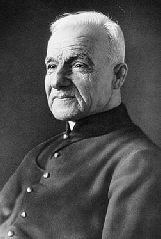 evidently came into the care
of her aunt, Marguerite Langlois, wife of Abraham Martin, with whom she returned
to Québec in 1633. In 1634 she married Guillaume Hébert, son of Louis Hébert. They
had three children before Guillaume’s untimely death, in 1639, including daughter
Françoise, born in 1638, from whom we descend. Also descending from Françoise was
her 5th great grandson, Alfred Bessette, born in 1845, who was canonized by the pope
in 2010 as Saint André of Canada. Saint André was a 5th cousin of Charles Duval and
therefore a cousin of all of us as well.
evidently came into the care
of her aunt, Marguerite Langlois, wife of Abraham Martin, with whom she returned
to Québec in 1633. In 1634 she married Guillaume Hébert, son of Louis Hébert. They
had three children before Guillaume’s untimely death, in 1639, including daughter
Françoise, born in 1638, from whom we descend. Also descending from Françoise was
her 5th great grandson, Alfred Bessette, born in 1845, who was canonized by the pope
in 2010 as Saint André of Canada. Saint André was a 5th cousin of Charles Duval and
therefore a cousin of all of us as well.
After Guillaume’s death, Hélène married Noel Morin, a wheel maker, with whom she
had twelve children, an experience that undoubtedly helped to qualify her for later
appointment as the town’s midwife. Among her children from this marriage, and therefore
distant cousins of ours, were Germain Morin, the first Canadian-
EARLY FAMILIES OF QUÉBEC
Apart from the five couples mentioned above in the discussion of Hélène Desportes, settlement in New France languished until the 1630s, when the Company of New France, which had been granted a trading monopoly by the king, began actively to recruit individuals and families to settle in the colony. The individuals were engaged by contract as laborers for several years, after which most of them returned to France. The families, on the other hand, were typically recruited by relatives or associates who were already involved in colonization, and they nearly all remained in Québec and established farms there. Over half of our earliest ancestors were among these families:
Marin Boucher and Perrine Mallet, settled in Québec by 1634
Nicolas Marsolet and Marie
LeBarbier, settled in Québec by 1637
Louis Sédilot and Marie Grimoult, settled in
Québec in 1637
Nicolas Pelletier and Jeanne de Vouzy, settled in Québec by 1637
Jean-
Jacques Archambault and
Françoise Tourault, settled in Québec by 1647
Jacques Badeau and Anne Ardouin, settled
in Québec by 1648
PIONEERS OF MONTRÉAL
As noted in the above historical narrative, our ancestors were especially prominent
in the founding of Montréal. The early history of the city is remarkable: establishment
of a religious outpost in 1642 at the very edge of the frontier by a small group
of determined settlers who received only warnings and discouragement from their contemporaries.
In that year 52 men and women, led by the pious nobleman Paul Chomedey de Maisonneuve,
then just thirty years old, built a small wooden palisade on a spit of land in the
St. Lawrence, today called Pointe-
Augustin Hébert (unrelated to our other Hébert ancestor, Louis) had distinguished himself by behaving very differently than his peers. He had come from Normandy to Québec in 1637 as a soldier and stone cutter. But rather than return to France at the end of his enlistment, as most soldiers did, he elected to remain and to join the courageous group that set out to establish the settlement on Montréal Island in 1642. Then he went on to do something even more unusual: he returned to Paris to marry Adrienne Duvivier, in 1646, and then came back with her to Montréal. It is difficult to imagine the thought and deliberation that must have led to this action, given that the small settlement in Montréal had already acquired the reputation as a killing field for the Iroquois.
One assumes that Augustin had been deeply moved by the religious devotion of the
leaders of the project and was able to convince his bride to share the hardships
and sacrifice. And ultimately he did sacrifice his life, evidently abducted and killed
by the Iroquois in 1653. He left his young  widow and three children, including daughter
Jeanne, from whom we descend. He also left them the large plot of land that had been
conceded to him in 1648 by Maisonneuve -
widow and three children, including daughter
Jeanne, from whom we descend. He also left them the large plot of land that had been
conceded to him in 1648 by Maisonneuve -
Augustin Hébert was just one of many victims of Iroquois attacks during the early years of Montréal. Yet determined colonists continued to risk their lives in support of the community. Several of our ancestors joined the settlement during this period:
Jean Descaries arrived soon after the first group of colonists. By trade he was a
charbonnier -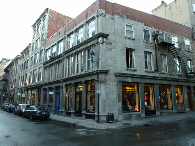 In 1650 Maisonneuve granted him
30 acres of land, bounded today by Boulevard René Lévesque, Rue de la Montagne, Rue
Versailles, and Rue William in downtown Montréal. Ten years later he was granted
a choice piece of land in the village, one acre near the market square, now called
Place Royale; the land today is on the north side of Rue St-
In 1650 Maisonneuve granted him
30 acres of land, bounded today by Boulevard René Lévesque, Rue de la Montagne, Rue
Versailles, and Rue William in downtown Montréal. Ten years later he was granted
a choice piece of land in the village, one acre near the market square, now called
Place Royale; the land today is on the north side of Rue St-
Blaise Juillet, from Avignon, came to Montréal in 1644 as an indentured laborer,
described as a bêcheur (ditch digger). After he had served his contracted term, he
remained in Montréal and was granted, in 1650, a plot of 30 acres of land, located
today along Rue Mansfield between Rue René Lévesque and Rue William in downtown Montréal.
In 1651 he married Anne-
Jacques Archambault and Françoise Tourault arrived in Québec by 1647, and within
a few years they and their six children joined the settlers in Montréal. 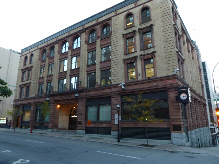 In 1651
Maisonneuve granted Jacques 30 acres of land adjacent to son-
In 1651
Maisonneuve granted Jacques 30 acres of land adjacent to son-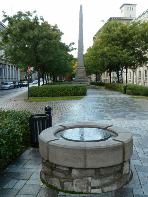 Montréal. He was also granted a fine one-
Montréal. He was also granted a fine one-
Urbain Tessier arrived in New France in the mid- he was granted 30 acres of land, located today on the west side of Rue St-
he was granted 30 acres of land, located today on the west side of Rue St-
Despite the steady arrival of new colonists as well as a few births to settler families,
the population of Montréal did not grow at all for the first ten years because of
constant losses to the Iroquois. It still consisted of just fifty souls in 1651,
leading Maisonneuve to despair for the future. He returned to France, determined
to recruit at least 100 settlers to augment the colony or, failing that, to abandon
the project entirely. In the event, he was successful in both raising money and attracting
recruits. In July 1653, over 100 men and 15 women departed from Saint-
Michelle Artus
Jean Auger
Paul Benoît
Julien Daubigeon
Marin Deniau
Pierre Desautels
Jean
Gervaise
Louis Guertin
Marin Hurtebise
Catherine Lorion
Pierre Mallet
Perrine Meunier
Jacques
Milot
Hugues Picard
Jeanne Soldé
The first detailed census of Montréal was taken ten years later, in 1663, by which time the total French population had grown to 596. Of these, 49 were our ancestors, and they held substantial portions of land in the nascent city.
DAUGHTERS AND SOLDIERS
Despite the commitment and efforts of Champlain, Maisonneuve, and many other advocates and pioneers over more than half a century, New France failed to grow and prosper at the rate of the British and Dutch colonies to the south. In 1663, the total French population of the St. Lawrence Valley had reached just 3,035. By contrast, New England had nearly 40,000 European settlers, New Netherland 9,000, Maryland 6,000, and Virginia 35,000. In that year, fresh impetus was given to the colonizing of New France by the young and vigorous French king, Louis XIV. Having for the moment settled European matters to his satisfaction, he took renewed interest in his languishing North American colony. He dismissed the merchant company that had failed to bring it prosperity and assumed direct responsibility for administration and colonization.
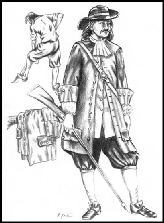 Concerned especially that the small French population continued to be vulnerable
to Iroquois attacks and that this was a major impediment to further settlement, the
king ordered that the Carignan-
Concerned especially that the small French population continued to be vulnerable
to Iroquois attacks and that this was a major impediment to further settlement, the
king ordered that the Carignan-
Etienne Charles
Bernard Deniger
René Dumas
Germain Gauthier
Hilaire Limousin
Louis Marier
Nicolas
Moison
Louis Robert
François Séguin
The king was no less concerned that the population of New France was heavily unbalanced
in favor of men and that it would not endure unless women could be made available
to marry and form families. He thus ordered that his agents recruit young women of
respectable parentage and 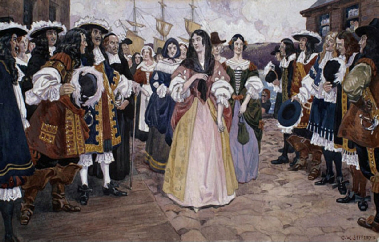 backgrounds, mostly from the area in and around Paris,
many of them orphans who had been raised by religious orders. Between 1663 and 1673,
770 young women, called Filles du Roi (King’s Daughters), were transported to New
France under this program. Upon arrival, they were placed under the strict supervision
of local nuns, who oversaw their introduction to eligible young men, and within a
few months virtually all were successfully married. The King’s Daughters constituted
nearly half of all the women who immigrated to New France and so became the firm
and broad base of the French-
backgrounds, mostly from the area in and around Paris,
many of them orphans who had been raised by religious orders. Between 1663 and 1673,
770 young women, called Filles du Roi (King’s Daughters), were transported to New
France under this program. Upon arrival, they were placed under the strict supervision
of local nuns, who oversaw their introduction to eligible young men, and within a
few months virtually all were successfully married. The King’s Daughters constituted
nearly half of all the women who immigrated to New France and so became the firm
and broad base of the French-
Anne Aubry
Jeanne Bernard
Jeanne Bilodeau
Marie Barbe Boyer
Louise Charrier
Jeanne Denot
Catherine
Ducharme
Mathurine Goard
Anne Grimbault
Madeleine Groleau
Marie-
Marguerite
Laverdure
Marguerite Leclerc
Antoinette Lefebvre
Marie Lelong
Catherine Lemesle
Catherine
Moitié
Madeleine Niel
Catherine Paulo
Jeanne Petit
Marie Anne Rabady
Marguerite Raisin
Georgette
Richer
Marguerite Richer
Anne Roy
Jeanne Servignan
Marguerite Vaillant
There are, of course, millions of descendents of the daughters and soldiers today
in Canada and the United States, including us. Descendants are eligible to join La
Société des Filles du roi et soldats du Carignan, a kind of low-
ADRIEN ST. AUBIN
Our St. Aubin line began in the New World with the arrival in Montréal in about 1665
of seventeen-
In 1680 Adrien married Jeanne-
ANNETJE CHRISTIAANSZ AND MOÏSE DUPUIS
Moïse Dupuis was born in Québec on 8 July 1673, the second child of immigrant parents
who later settled in Laprairie, near Montréal. As a teenager Moïse followed the path
taken by many young Frenchmen in Canada and became a coureur-
Annetje Christiaansz, according to the findings of reputable researchers, was probably
the out-
What do we know of Annetje’s parents? Her father, Christiaan Christiaansz, was born in the Netherlands in about 1640 and arrived on the Hudson River in 1659, where he had been hired as an indentured laborer by the prominent van Rensselaer family of Rensselaerswyck, near Albany. By 1671 he completed his indenture and purchased a small plot of land in Schenectady, which was then a community of fewer than 200 settlers on the frontier of Mohawk country. He was still a junior member of the community five years later when Annetje was born.
Annetje’s mother, whose name we do not know, was of African descent and undoubtedly
a slave. At that time there were about a dozen African slaves in Schenectady, most
of them female, engaged in domestic and farm labor for individual families. It is
likely that she had been imported from one of the plantation settlements in the Caribbean
-
Edgar McManus, the leading authority on slavery in New Netherland, notes that the Dutch were largely free of racial prejudice and treated their slaves in much the same way as they treated indentured European workers, as an expensive source of labor to be sensibly exploited but not abused: “Despite their unequal relationship, masters and slaves worked together at the same tasks, lived together in the same houses, and celebrated the Dutch holidays together on terms of easy familiarity.” We do not know if she and Christiaan were more than casual acquaintances. It is unlikely that he owned her, since he was not yet wealthy enough to afford the current price of a slave, which was about one year’s wages for an adult male worker. But he may have leased her, a common practice at that time.
Soon after their marriage, in 1697, Annetje and Moïse moved to Québec, where in 1699 she was baptized in the Catholic Church and given the names Marie Anne Louise. The couple settled in Laprairie, near Moïse’s parents, and had nine children, most of whom survived to adulthood. We descend from their daughter Barbe, born in 1715. Both Moïse and Annetje died in 1750.
PIERRE EDMÉ THUOT DIT DUVAL
The first Duval of our line in New France was Pierre Edmé Thuot dit Duval, born in
1681 in Tonnerre, a town in Burgundy about 120 miles southeast of Paris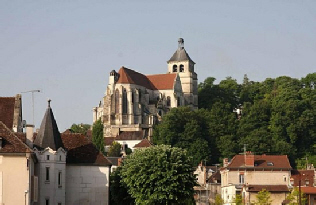 . He was a
son of master baker Edmé Thuot, who in 1668 had married Marie Louise Duval, daughter
of François Duval, a huissier royal (royal bailiff). With this match, Edmé took a
definite upward social step in class-
. He was a
son of master baker Edmé Thuot, who in 1668 had married Marie Louise Duval, daughter
of François Duval, a huissier royal (royal bailiff). With this match, Edmé took a
definite upward social step in class-
Pierre was, interestingly, the next to last of our 185 immigrant ancestors to arrive
in New France. By 1709 he was in Montréal, which we know because he fathered an illegitimate
child there who was born early the following year. By 1712 he was established in
Montréal as a master baker, and in that year he married Marie Fournier. Marie was
a granddaughter of an immigran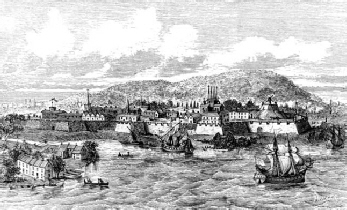 t from the town of Irancy, which is just twenty miles
from Tonnerre, and it is possible that this connection sheds light on Pierre’s decision
to immigrate to New France, given that very few settlers otherwise came from this
part of France.
t from the town of Irancy, which is just twenty miles
from Tonnerre, and it is possible that this connection sheds light on Pierre’s decision
to immigrate to New France, given that very few settlers otherwise came from this
part of France.
Pierre and Marie moved between Montréal and Québec City several times, which suggests
that his baking enterprise may have been more than just a single shop. Between 1713
and 1725 they had ten children, the last of whom was Thomas Ignace, great-
CHARLES, SARAH, AND THEIR CHILDREN
CHARLES DUVAL, 1843-1924
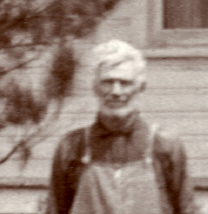 Charles Duval was born on 27 April 1843 in Ste-
Charles Duval was born on 27 April 1843 in Ste-
It is important to note that the surname given to Charles at baptism was not Duval
but rather Thuot (pronounced TYOO-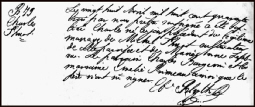 preferred to call themselves
Thuot. It was only later in life that Charles chose to use Duval exclusively as his
surname, probably because it was easier for English-
preferred to call themselves
Thuot. It was only later in life that Charles chose to use Duval exclusively as his
surname, probably because it was easier for English-
In the late 1840s, Charles’s family moved to the nearby village of Beauharnois and
then by 1849 settled in St-
In early 1858, at the age of 14, Charles set off, probably with a group of relatives
and friends, to find work in the United States. He entered at the port of Detroit
and probably stayed in the area for a while as a farm worker and perhaps as a carpenter
and construction worker, for which he had received some training. Before long, however,
he returned to Canada, probably to avoid conscription by the Union army in the U.S.
Civil War. In 1861, he was again with his parents in Québec, in the village of St-
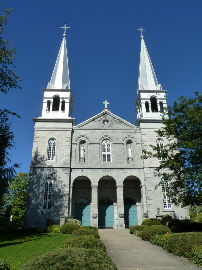 In 1865, at the age of 21, Charles married for the first time, in the parish church
of St-
In 1865, at the age of 21, Charles married for the first time, in the parish church
of St-
In 1871 Charles was living in St-
By this point in his life, Charles, like hundreds of thousands of his fellow French
Canadians at that time, had decided to emigrate to the United States, where both
land and employment opportunities were far more abundant than in Québec. In preparation
for emigration, he traveled to the United States and may have devoted as much as
a year to exploring possible destinations. While the great majority of French Canadian
emigrants moved to New England, Charles chose instead to settle in central Wisconsin,
near the village of Unity, on the border between Clark and Marathon counties. While
his reasons for selection of this village are not known, it should be noted that
a few French Canadian families were already settled there and that Charles may have
previously been in communication with them. During his absence in the United States,
Charles left his two daughters in the care of his mother-
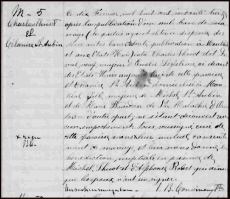 By early 1873 Charles had returned to Québec. On February 10th of that year, in the
parish church of St-
By early 1873 Charles had returned to Québec. On February 10th of that year, in the
parish church of St-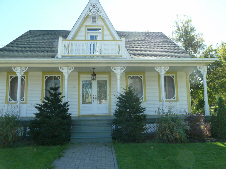 greement make it clear that this was
unlikely to happen and that it was intended that they remain permanently with their
grandmother and uncle in Québec, which they ultimately did.
greement make it clear that this was
unlikely to happen and that it was intended that they remain permanently with their
grandmother and uncle in Québec, which they ultimately did.
By the middle of the year 1873 Charles and his wife Célanire, who called herself Sarah after settling in Wisconsin, had arrived near Unity and had rented a house and probably a small farm, where Charles could both cultivate crops and engage in his trade of carpentry and construction work. In December their first child, Charles, was born. Over the following twelve years eight more children were born, all but one of whom survived to adulthood. By 1880 Charles and Célanire had been joined in Wisconsin by four members of Charles’s family: his father Michel, his mother Marie Anne (née Lefebvre), and his younger siblings Philomène, who married Hubert Beaudin in about 1875, and Alexis, who married Delia Leclaire in Dorchester, Wisconsin, in 1880.
In 1877 Charles purchased his first significant piece of real estate, 160 acres in Brighton, Marathon County, just to the east of Unity. In 1888, by which time he and Célanire had moved to Marshfield, Wood County, he sold the land in Brighton and then in 1889 purchased 160 acres just southwest of Unity, in Clark County. In 1897 he lost this property in foreclosure and moved to a rented farm near Unity, where his main source of income again became carpentry and construction work. Soon after 1900 he moved to forty acres of farmland that he had purchased in McMillan, Marathon County, to the east of Unity, where he and Célanire lived for the rest of their lives.
Charles died on 21 May 1924 in Marshfield, Wisconsin, from injuries suffered from falling down a stairway at the home of his granddaughter Julia Duval on her wedding day.
SARAH DUVAL (MARIE CÉLANIRE ST. AUBIN), 1847-1924
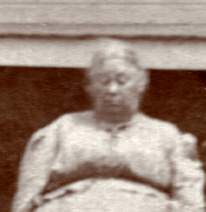 Marie Célanire St. Aubin, whom her children and grandchildren knew as Sarah, was
born on 18 June 1847 in the village of Ormstown, Québec, about twenty miles south
of Montréal. She was a daughter of Michel St. Aubin and Marie Bourdon, who had been
married in the nearby town of Chateauguay in 1840. Michel and Marie had seven children
between 1841 and 1854, six of whom survived to adulthood.
Marie Célanire St. Aubin, whom her children and grandchildren knew as Sarah, was
born on 18 June 1847 in the village of Ormstown, Québec, about twenty miles south
of Montréal. She was a daughter of Michel St. Aubin and Marie Bourdon, who had been
married in the nearby town of Chateauguay in 1840. Michel and Marie had seven children
between 1841 and 1854, six of whom survived to adulthood.
Since Célanire’s father was a laborer, the family moved frequently from village to
village in the rural area south of Montréal as he sought work. Over the years, they
lived in Ste-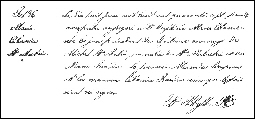 her twenty-
her twenty-
On 10 February 1873, she married Charles Duval in St-
In the United States, Célanire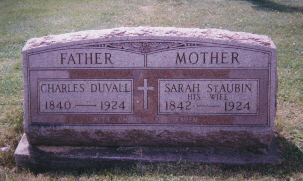 soon began calling herself Sarah, perhaps because
her real name was unfamiliar to her new, English-
soon began calling herself Sarah, perhaps because
her real name was unfamiliar to her new, English-
Like Charles, Célanire never learned to read or write.
Célanire/Sarah died on 22 March 1924 in McMillan, Marathon County, from complications of diabetes.
THE CHILDREN OF CHARLES AND SARAH
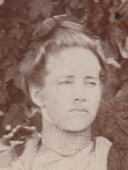 Charles, the first child of Charles and Sarah, was born in Unity on 19 December 1873
and baptized five months later at St. Stephen’s in Stevens Point, which was the nearest
Catholic church to Unity at that time. In 1893 in Colby, Clark County, he married
Mary Elizabeth Rocheleau, daughter of French-
Charles, the first child of Charles and Sarah, was born in Unity on 19 December 1873
and baptized five months later at St. Stephen’s in Stevens Point, which was the nearest
Catholic church to Unity at that time. In 1893 in Colby, Clark County, he married
Mary Elizabeth Rocheleau, daughter of French-
CHILDREN OF CHARLES AND MARY (ROCHELEAU) DUVAL
 Leo Charles Duval, 1893-
Leo Charles Duval, 1893- Edwin Thomas Duval, 1896-
Edwin Thomas Duval, 1896-
 Clara Loretta Duval, 1898-
Clara Loretta Duval, 1898- Ozilda Mary Duval, 1901-
Ozilda Mary Duval, 1901-
 Laura Loretta Duval, 1903-
Laura Loretta Duval, 1903-
Emery Michael Duval 1906-
Lawrence Frank Duval, 1909-
Agnes Elnora Duval, 1912-
Ione Violet Duval, 1917-
MARIE MAUDE DUVAL, 1875-after 1930
Maude, the oldest daughter of Charles and Sarah, was born in Unity on 12 January 1875 and baptized three months later at St. Stephen’s in Stevens Point. In 1889 in Colby she married Joseph Paquin, with whom she evidently had no surviving children. Joseph died in about 1895, and in 1896 in Marshfield, Wood County, she married William Adelbert Sheldon, with whom she had one son. By 1910 the family had settled in Harlowton, Montana. William died in Montana between 1920 and 1930, and Maude was still living in Harlowton in 1930, supporting herself by taking in lodgers.
MARCIAN THEODORE (CLAUDE) DUVAL, 1876-1952
Marcian Theodore, the third child of Charles and Sarah, who called himself Claude, was born in Unity on 14 March 1876 and baptized two weeks later at St. Stephen’s in Stevens Point. By 1900 he had moved to Montana and settled in Gilt Edge, Fergus County. By 1920 he was in Everett, Washington, working as a railroad car repairer. By 1930 he had moved to South Lake Stevens, Washington, and was working on a farm. Although he married twice, he was evidently childless. He died in Hewitt, Wood County, Wisconsin, in 1952.
THOMAS DUVAL, 1878-1963
Thomas, the fourth child of Charles and Sarah, was born in Unity on 23 May 1878 and baptized ten weeks later at St. John’s Catholic Church in Marshfield. His godparents were Michel Thuot dit Duval and Marie Anne Lefebvre Duval, his grandparents, who had by then joined Charles and Sarah in Wisconsin. By 1900, he had settled in Rondell, South Dakota, where in 1901 he married Minnie Dayton, with whom he had three children between 1902 and 1908. The family moved to Fergus County, Montana, by 1920, and Thomas continued to work as a farmer. Minnie died there, in the town of Lewiston, in 1962, and Thomas died the following year.
LOUIS ALFRED (FRED) DUVAL, 1879-after 1930
Louis Alfred, the fifth child of Charles and Sarah, who called himself Fred, was born in Unity on 1 September 1879 and baptized two months later at St. John’s Catholic Church in Marshfield. He remained in Wisconsin, close to his parents, and in about 1906 he married Marie Hebert. They had six children between 1908 and 1918. We lose track of him in later records, but it may be he who is found in 1930 in La Plata County, Colorado, living alone as a boarder (though married) and employed as a farm laborer.
FRAN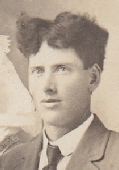 CIS XAVIER (FRANK) DUVAL, 1880-
CIS XAVIER (FRANK) DUVAL, 1880-1951
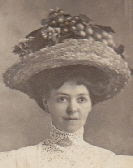 Francis Xavier, the sixth child of Charles and Sarah, who called himself Frank, was
born in Unity on 1 December 1880 and baptized eight months later at St. John’s Catholic
Church in Marshfield. His godparents were his uncle François Xavier St. Aubin and
his aunt Marie Marguerite St. Aubin, who by this time had joined Charles and Sarah
in Wisconsin. In 1909 in Marshfield Frank married Alma Stella Boucher, daughter of
French-
Francis Xavier, the sixth child of Charles and Sarah, who called himself Frank, was
born in Unity on 1 December 1880 and baptized eight months later at St. John’s Catholic
Church in Marshfield. His godparents were his uncle François Xavier St. Aubin and
his aunt Marie Marguerite St. Aubin, who by this time had joined Charles and Sarah
in Wisconsin. In 1909 in Marshfield Frank married Alma Stella Boucher, daughter of
French-
CHILDREN OF FRANK AND STELLA (BOUCHER) DUVAL
 Michael Lloyd Duval, 1910-
Michael Lloyd Duval, 1910- Pearl Victoria Duval, 1918-
Pearl Victoria Duval, 1918- Gordon Louis Duval, b.1923
Gordon Louis Duval, b.1923
MICHAEL ANDREW DUVAL, 1882-1925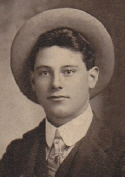

Michael, the seventh child of Charles and Sarah, was born in Unity on 28 December 1882 and baptized five weeks later at St. John’s Catholic Church in Marshfield. His godparents were his aunt Marie Marguerite St. Aubin and her husband David Viau, who had recently married. As Michael grew up, he developed into an attractive, intelligent, ambitious, and hard working man, but he wasn’t the kind of person who would get a steady job and meticulously climb the ladder of success. Instead, he was restless and was always looking for an angle and for a way to make his fortune. He clearly enjoyed life and people and liked to have a good time.
He left school 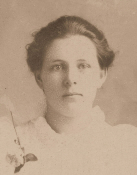 early, as did almost everyone at that time, and by the age of sixteen
he was working as a lumberjack. His first big opportunity occurred when he met Elizabeth
(Lizzie) Beaver and convinced her to marry him. He recognized in her a person who
was his total opposite -
early, as did almost everyone at that time, and by the age of sixteen
he was working as a lumberjack. His first big opportunity occurred when he met Elizabeth
(Lizzie) Beaver and convinced her to marry him. He recognized in her a person who
was his total opposite -
For several years Michael produced and delivered cheese, and he even managed to invent
a device for improving the efficiency of cheese manufacture, 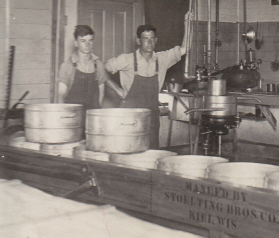 which he patented, but
he never realized any benefit from the invention, possibly because the potential
market was too small. It seems as well that he thought of himself as an inventor,
because he devoted some effort to one of the great fantasies of that time, the discovery
of a “perpetual motion” machine, which would run forever on its own momentum, without
fuel. The successful inventor of such a machine would, of course, be wealthy beyond
his dreams.
which he patented, but
he never realized any benefit from the invention, possibly because the potential
market was too small. It seems as well that he thought of himself as an inventor,
because he devoted some effort to one of the great fantasies of that time, the discovery
of a “perpetual motion” machine, which would run forever on its own momentum, without
fuel. The successful inventor of such a machine would, of course, be wealthy beyond
his dreams.
By 1920, Michael had disposed of the cheese factory and was in the business of upholstering
furniture. In 1921, he left that work and opened a shop with his brother Charles
at 327 North Central in Marshfield that distributed auto batteries, carburetors,
and tires. (His brother in law Philip Beaver operated an auto repair shop at the
same address.) But at this point a new opportunity came his way. The enactment of
the Eighteenth Amendment to the U.S. Constitution, in 1920, prohibited the manufacture
and sale of alcoholic beverages. Men in rural communities across the country saw
an opportunity -
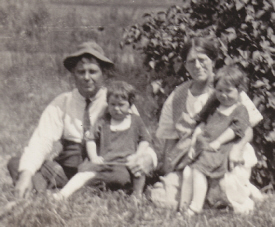 By about 1922 Michael had moved his family a few miles outside of Marshfield to a
rented farm and was manufacturing and selling moonshine. It was evidently an open
secret that he was engaged in this activity, and it is likely that local law enforcement
officers enjoyed his products and perhaps even received a share of his profits. The
money rolled in, and soon Michael was looking for a way to invest it and build his
fortune.
By about 1922 Michael had moved his family a few miles outside of Marshfield to a
rented farm and was manufacturing and selling moonshine. It was evidently an open
secret that he was engaged in this activity, and it is likely that local law enforcement
officers enjoyed his products and perhaps even received a share of his profits. The
money rolled in, and soon Michael was looking for a way to invest it and build his
fortune.
Prohibition brought many changes in the 1920s in America. Although it was well intentioned, it led to the rise of a vast underworld serving the public’s unquenchable thirst for alcohol. Organized gangs, most notably the mafia, smuggled bottled liquor into the country in great quantities; amateur distilleries were built across the country; and entrepreneurs in every town and city opened speakeasies, where paying customers could get a drink and have a good time. Urban centers, such as Chicago and New York, witnessed the rise of a new class of wealthy men, who made their fortunes from this trade and liberally spread their wealth to those who surrounded and served them.
Wisconsin became a special beneficiary of the new prohibition wealth when Chicago gangsters discovered the attractions of the lakes in the northern part of the state, near Rhinelander. Soon, their vacation retreats began to appear on the lakeshores, and speakeasies and other establishments were opened to serve a new class of customers.
Michael, always open to new opportunities, and now in possession of his moonshining
profits, traveled to Rhinelander, scouted the surrounding area, and in 1925 purchased
a plot of land on a lake to the west of nearby Woodruff. 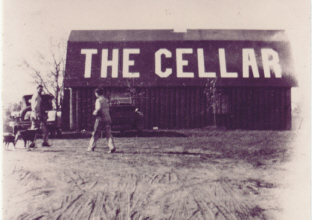 In August of that year,
he began construction of a two story building near the lake that was to be a nightclub
(and speakeasy) as well as a new home for his family. In November, as the building
was nearing completion, he brought his family up from Marshfield to join him.
In August of that year,
he began construction of a two story building near the lake that was to be a nightclub
(and speakeasy) as well as a new home for his family. In November, as the building
was nearing completion, he brought his family up from Marshfield to join him.
On the evening of Sunday, December 20, the day that the family moved from the old house on the property to the new house, Michael gathered a few friends to celebrate, drink, and play music. (Michael himself played the violin.) Among the friends was Charles J. (Charley) Rey, who had come up from Marshfield the previous day by train and had spent the night with the family.
Charley Rey was a nearly illiterate laborer who was, at that time, 67 years old and
therefore 25 years older than Michael. In about 1915 he had moved from his native
Michigan to Marshfield, where he got a job as a street sweeper for the town. In the
early 1920s -
In any case, on the evening of December 20, Charley Rey mortally wounded Michael with a shot from a revolver that he had brought with him from Marshfield. Michael was taken to a hospital in Rhinelander, where he died on Christmas day. The subsequent police investigation and jury trial declared that Rey had been temporarily insane at the time as a result of the ingestion of a toxic amount of moonshine and that he had not been criminally responsible for his actions. He was committed to the Central State Hospital for the Insane in Waupun, Wisconsin, where he remained until his death in 1932. While the verdict of temporary insanity is supported by the evidence presented in the transcript of the trial, it is not certain that the full story was told or will ever be known. Family photos . . .
CHILDREN OF MICHAEL AND ELIZABETH (BEAVER) DUVAL
 Alvin Frank Duval, 1904-
Alvin Frank Duval, 1904- Julia B. Duval, 1905-
Julia B. Duval, 1905-
 Raymond Carl (Ray) Duval, 1908-
Raymond Carl (Ray) Duval, 1908- Cecilia Anna (Ceil) Duval, 1910-
Cecilia Anna (Ceil) Duval, 1910-
 Francis Gilbert (Gil) Duval, 1912-
Francis Gilbert (Gil) Duval, 1912- Pius Leopold Duval, 1914-
Pius Leopold Duval, 1914-
 Genevieve Adaline (Geneva) Duval, 1916-
Genevieve Adaline (Geneva) Duval, 1916- Harold Frederic Duval, 1918-
Harold Frederic Duval, 1918-
 Helen Ann Duval, 1922-
Helen Ann Duval, 1922- Evelyn Marie Duval, 1922-
Evelyn Marie Duval, 1922-
 Donald John Duval, 1924-
Donald John Duval, 1924-
MARY CLARE (EDNA or MAMIE) DUVAL, 1885-after 1930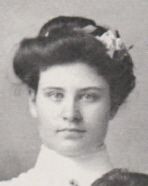

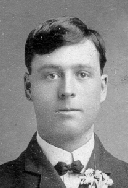 Mary Clare, the last child of Charles and Sarah, who called herself Edna or Mamie,
was born in Unity on 26 September 1885 and baptized two weeks later at St. Mary's
Catholic Church in Colby. In 1908 she married Francis Mathias (Frank) Herman, and
they settled in Spencer, Wisconsin, where they had five children. Frank died in 1953
in Marshfield, and Edna died sometime after him. Family photos . . .
Mary Clare, the last child of Charles and Sarah, who called herself Edna or Mamie,
was born in Unity on 26 September 1885 and baptized two weeks later at St. Mary's
Catholic Church in Colby. In 1908 she married Francis Mathias (Frank) Herman, and
they settled in Spencer, Wisconsin, where they had five children. Frank died in 1953
in Marshfield, and Edna died sometime after him. Family photos . . .
THE DUVAL FAMILY TREE
FRENCH-CANADIAN ANCESTRY
To have French-
Our Duval family tree currently consists of 745 ancestors, with most lines finding their origins in specific towns and villages in France and extending in many cases to the 1500s. All but four ancestral lines were French. The exceptions are a line originating in Burgos, Spain (Alve), one in Basel, Switzerland (Lebreul), one in the Netherlands (Christiaanz), and one in Africa. Notwithstanding the suggestion of one Duval researcher, there were no Native American (Indian) ancestors at all.
Of the 745 ancestors, 185 were of the generation of immigrants to French Canada,
with nearly all arriving in the 1600s. Two-
THE ORIGIN OF THE NAME DUVAL
There is a long tradition in France of “dit” names -
Our Charles Duval (1843-
In general, the extended family used only Thuot when referring to themselves in Québec,
although “dit Duval” was occasionally added to it or even used alone. The use of
Duval as the sole surname began to occur consistently when family members emigrated
to the United States or to western Canada, probably because they found that their
new English-
In France and in Québec, the name has always been spelled Duval, pronounced Dyoo-
OUR 745 ANCESTORS
The complete family tree of Charles and Sarah is now available on line at Ancestry.com. This link takes you to the page for their son Michael, but any of their children can be used as an entry point.
SOURCES AND NOTES
HISTORY OF FRENCH CANADA
Barkan, Elliott Robert, “French Canadians,” in the Harvard Encyclopedia of American
Ethnic Groups, ed. Stephan Thernstrom (Cambridge, 1980), pages 388-
Brown, Craig (editor), The Illustrated History of Canada, 5th edition (Toronto, 2007).
A very good one-
Bumsted, J.M., The Peoples of Canada: A Pre-
Charbonneau, Hubert, et al, The First French Canadians: Pioneers in the St. Lawrence Valley (Newark, 1993). In effect, a detailed summary of everything learned over the previous twenty years by the team of demographers at the University of Montréal who have assembled, computerized, and analyzed the vital records of the first two centuries of Québec. Indispensable.
Dechêne, Louise, Habitants and Merchants in Seventeenth Century Montréal (Montréal, 1992). Translation of the groundbreaking quantitative study of the early economy and society of Montréal, originally published in French in 1974.
Delâge, Denys, Bitter Feast: Amerindians and Europeans in Northeastern North America,
1600-
Dickenson, John, and Brian Young, A Short History of Québec (Montréal, 2008). A thoroughgoing materialist survey of social and economic history. Good background to the current political environment.
Douville, Raymond, and Jacques Casanova, Daily Life in Early Canada (London, 1968).
A fairly good compendium of anecdotal details regarding the various social classes,
although it is decidedly pro-
Eccles, W.J., Canada under Louis XIV, 1663-
Eccles, W.J., The French in North America, 1500-
Fischer, David Hackett, Champlain’s Dream (New York, 2008). Wonderfully readable
despite being deeply detailed and undeniably scholarly, this dense volume by a Pulitzer
Prize-
Fournier, Marcel, Les Premiers Montréalistes, 1642-
Greer, Allan, The Patriots and the People: The Rebellion of 1837 in Rural Lower Canada (Toronto, 1993). Places the events of the 1830s in their historical context, with detailed background on social and economic conditions.
Greer, Allan, Peasant, Lord, and Merchant: Rural Society in Three Quebec Parishes
1740-
Greer, Allan, The People of New France (Toronto, 1997). Concise and well written, but limited in scope, occasionally glib, and unfailingly politically correct.
Neatby, Hilda, Quebec: the Revolutionary Age, 1760-
Lanctot, Gustave, Montreal under Maisonneuve, 1642-
Litalien, Raymonde, and Denis Vaugeois, editors, Champlain: The Birth of French America
(Montréal, 2004). Lavishly illustrated coffee-
Miquelon, Dale, New France, 1701-
Moogk, Peter N., La Nouvelle France: The Making of French Canada -
Ouellet, Fernand, Lower Canada, 1791-
Snow, Dan, Death or Victory: The Battle for Quebec and the Birth of Empire (London,
2009). A detailed and very readable -
Stanley, George F.G., New France: The Last Phase, 1744-
Trudel, Marcel, Introduction to New France (Pawtucket, 1997). Translation of the
1968 work in French. Quirky and rough-
Trudel, Marcel, The Beginnings of New France, 1524-
PIONEERS OF MONTRÉAL
Auger, Roland, La Grande Recrue de 1653 (Montréal, 1955). The first detailed study, and now a classic. An inadequate English translation is available (Pawtucket, 2002).
Langlois, Michel, Montréal 1653: La Grande Recrue (Sillery, 2003). A much-
Trudel, Marcel, Montréal: la formation d’une societé, 1642-
DAUGHTERS AND SOLDIERS
Landry, Yves, Orphelines en France, pionnières au Canada: les Filles du roi au XVIIe siècle (Ottawa, 1992). Authoritative, thorough, and complete.
Verney, Jack, The Good Regiment: The Carignan-
LOUIS HEBERT
Bennett, Ethel M.G., “Hébert, Louis,” Dictionary of Canadian Biography.
Couillard-
Faragher, John Mack, A Great and Noble Scheme (New York, 2005). Succinctly describes the early Acadian settlements.
Fischer, David Hackett, Champlain’s Dream (New York, 2008). Includes a useful discussion of Hébert’s relationship with Champlain.
Goulet, George and Terry, Louis Hébert and Marie Rollet: Canada’s Premier Pioneers (Calgary, 2007). Full of misinformation and stylistically reminiscent of a term paper written by a mediocre tenth grader.
Jurgens, M., “Recherches sur Louis Hébert et sa famille,” Mémoires de la Société
généalogique canadienne-
NICOLAS MARSOLET
Fischer, David Hackett, Champlain’s Dream (New York, 2008). Good summary of Marsolet’s interactions with Champlain, although overwhelmingly biased toward the latter individual.
Trigger, Bruce G., Natives and Newcomers: Canada’s “Heroic Age” Reconsidered (Montreal, 1985). Useful sections on the Montagnais’ relations with the French from their point of view.
Trudel, Marcel, “Charité, Espérance, Foi,” Dictionary of Canadian Biography. The author, normally skeptical and incisive, in this instance accepts Champlain’s narrative of the two Indian girls without question.
Vachon, André, “Marsolet de Saint-
ANNETJE CHRISTIAANSZ AND MOÏSE DUPUIS
The University of Montréal’s authoritative Programme de recherche en démographie
historique (PRDH) considers it “probable” that the “semi-
Barth, Barbara A., "The Family of Ysbrant Eldersz of Rennselaerswyck," New York Genealogical and Biographical Record, October 1997. Summarizes what is known about Christiaan Christiaansz.
Burke, Thomas E., Mohawk Frontier: The Dutch Community of Schenectady, 1661-
McManus, Edgar J., A History of Negro Slavery in New York (Syracuse, 1966).
PIERRE EDMÉ THUOT DIT DUVAL
Genealogica and Heraldica -
CHARLES AND SARAH DUVAL
1858 entry to Michigan: Declaration of Intention to Become a Citizen of Charles Duval, Wood County, Wisconsin, 23 October 1886.
1871: Census of Canada, Québec Province, Beauharnois District, page 126.
1872: visit to the United States: Charles’s 1873 marriage record states that he was
“ci-
1873 marriage: Parish register of St-
1873 agreement with Louis Lefebvre regarding his children: Notarial records of E.H.
Bisson, number 3778, dated 3 March 1873, St-
1875 Wisconsin census: in Brighton, Marathon County.
1877 land purchase: deed dated 26 March 1877, Marathon County.
1880 US census: in Brighton, Marathon County.
1885 Wisconsin census: in Brighton, Marathon County.
1888 land sale: deed dated 19 April 1888, Marathon County.
1889 land purchase: deed dated 9 March 1889, Marathon County.
1895 Wisconsin census: in Unity, Clark County.
1897 foreclosure: see Clark County land documents, vol. 55, page 428.
1900 US census: in Unity, Clark County. Charles now rents a farm, and his primary occupation is carpentry.
Farmland in McMillan after 1900: See Wausau City/Marathon County directories of 1899. The forty acres were in Section 30, Township 26, Range 3.
1905 Wisconsin census: in McMillan, Marathon County. Charles now owns a mortgaged farm, and his primary occupation is farmer.
1910 US census: in McMillan, Marathon County. Charles owns a mortgaged farm, and his primary occupation is farmer.
1920 US census: in McMillan, Marathon County. Charles is retired.
MICHAEL ANDREW DUVAL
Michael’s planned speakeasy, for which he purchased land on 27 July 1925, was in Vilas County, Lots 1 and 2, NE of NE, Section 34, Township 40, Range 6 East. The price of the land was $5,000, with $100 down and the rest to be paid within five years at 5% interest. The trust holders (the previous owners) filed an action of foreclosure on 28 December 1929 and repossessed the property. Following the death in 1928 of Michael’s oldest son, Alvin, who had operated the speakeasy after his father’s death, the family could no longer afford to operate the speakeasy and make payments. Apart from Alvin, the family had returned to Marshfield soon after Michael’s death. The structure that Michael built is still standing and in use as a private residence.
CONTACT THE AUTHOR
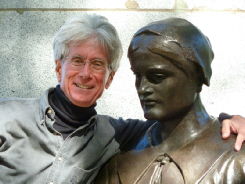 This site was written and designed by Robert Jackson, great-
This site was written and designed by Robert Jackson, great-
Please feel free to make suggestions for improving this site!
